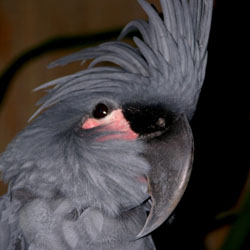Temperature
 Wild parrots are native to tropical and subtropical climates where temperatures generally range from 70-95 °F with humidity levels running 77-88%. In the wild, parrots can take action to regulate their temperature as needed by moving into the shade of leaves or into sunny clearings. Domestic parrots however, rely mainly on their human companions to regulate the temperature in their environment.
Wild parrots are native to tropical and subtropical climates where temperatures generally range from 70-95 °F with humidity levels running 77-88%. In the wild, parrots can take action to regulate their temperature as needed by moving into the shade of leaves or into sunny clearings. Domestic parrots however, rely mainly on their human companions to regulate the temperature in their environment.
For birds living in our homes, temperatures typically fluctuate very little from one season to the next as we humans like to maintain a relatively constant indoor temperature of 65-72 °F year round. Unless we have an unusual circumstance, such as a winter power failure or a broken air conditioning system, our parrots environment as it relates to temperature is fairly regulated.
Parrots have the ability to adapt to a wide range of temperatures but, once your parrot companion becomes accustomed to your home atmosphere, its internal wild furnace is essentially turned off. This does not mean that parrots can no longer adapt to temperatures above and below what is typical in our homes. It only means that parrots need to be acclimated slowly for larger temperature ranges. Problems occur when birds are exposed to rapid temperature changes. Variances greater than 10 to 15 degrees within a 24 hour time period may prove detrimental to your bird’s health.
Under extreme temperature conditions, heat stroke and hypothermia can occur and parrot owners should be aware of the warning signs and take appropriate corrective measures.
Here are some guidelines to assist your bird in regulating its bodily temperature:
It's Too Dang Hot!
- Always keep your bird's cage out of direct sunlight or, at a minimum, ensure they have a spot where they can retreat from the sunlight within their cage.
- Keep cages at least 12-18 inches away from exterior windows to avoid drafts.
- If the room temperature rises above 85 °F, room air movement is needed. You may wish to use a fan or crack a window to increase room air flow.
- Don't place your bird's cage directly in front of a fan or air conditioner.
- Never ever leave your bird in a car on a hot day. It takes as little as 10-15 minutes for heat stroke to kill a bird.
- Daily misting and cool (not cold) water showers will help your birds regulate their temperature on hot days.
- Skinny birds may have difficulty regulating the cold, while obese birds may have difficulty with the heat. Be extra vigilant under these conditions.
- In outside aviaries, always provide plenty of shade with access to lots of cool water for bathing and consumption. Check throughout the day to make sure your bird still has access to shade.
Baby It's Cold Outside
- Place a safe space heater in close proximity to the cage area, but not so close that it will be hazardous to your bird. Be careful to use heaters that do not give off any noxious fumes.
- Acclimate your parrot slowly as temperatures begin to get cold in fall and warm in the spring.
- Use a heated perch inside your bird’s cage to keep their feet warm.
- Give your bird a tent or other snugglie to help keep him warm.
- If your bird gets chilled, warm it on a heating pad, massage its feet to aid circulation and/or put small birds under your clothing to warm them with your body heat.







Comments powered by CComment